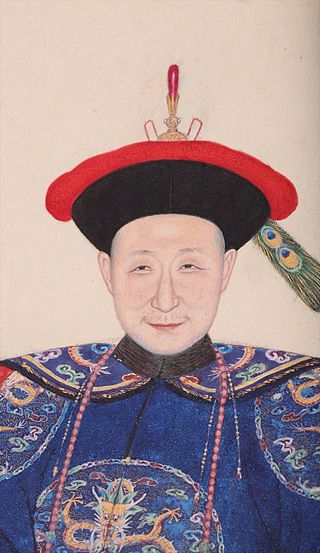Top Qs
Timeline
Chat
Perspective
Fuk'anggan
Manchu nobleman and general From Wikipedia, the free encyclopedia
Remove ads
Fuk'anggan (Manchu:ᡶᡠᠺᠠᠩᡤᠠᠨ, Möllendorff: Fuk'anggan;[1][2] Chinese: 福康安; pinyin: Fúkāng'ān; 1748–1796), courtesy name Yaolin (瑶林; 瑤林; Yáolín), was a Qing dynasty general from the Fuca clan of the Manchu Bordered Yellow Banner.
Fuk'anggan's father, Fuheng, brother of the Empress Xiaoxianchun, served as a grand minister of state during the middle years of the reign of the Qianlong Emperor. Fuk'anggan held various offices throughout Qianlong's reign, including Governor-General, Viceroy of Liangjiang and Viceroy of Liangguang.
The Salar Jahriyya revolt in Gansu was put down by Fuk'anggan along with Agui and Li Shiyao in 1784,[3][4] while Heshen was recalled for his failure during the revolt.[5]
In 1787, 300,000 people took part in the Lin Shuangwen rebellion in Taiwan against the Qing government. Fuk'anggan commanded 20,000 troops and suppressed the rebellion.[6] In 1790, the Nepalese Gurkha army invaded Tibet and the 8th Dalai Lama, Jamphel Gyatso, escaped from Lhasa and appealed to the Qing government for help. The Qianlong Emperor appointed Fuk'anggan as commander-in-chief of the Tibetan campaign and Fuk'anggan attacked until they reach Nuwakot and being keen to protect their troops went for negotiation in the Sino-Nepalese War.[7]
Remove ads
Titles
- 1776–1784: Viscount Jiayong of the Third Rank (三等嘉勇男)
- 1784–1787: Marquiss Jiayong of the First Rank (一等嘉勇侯)
- 1787–1793: Duke Jiayong of the First Rank (一等嘉勇公)
- 1793–1796: Duke Zhongrui Jiayong (忠銳嘉勇公)
- Posthumous title: Prince Jiayong of the Second Rank (嘉勇郡王)
In popular culture
- As a character in Jin Yong's novel The Book and the Sword and The Young Flying Fox
- Portrayed by Wang Yizhe in Yanxi Palace: Princess Adventure (2019)
- Portrayed by Ye Xiangming in Side Story of Volant Fox (2022)
References
External links
Wikiwand - on
Seamless Wikipedia browsing. On steroids.
Remove ads

